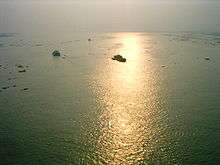Meghna River

The Meghna River (Bengali: মেঘনা নদী) is one of the most important rivers in Bangladesh,[1] one of the three that forms the Ganges Delta, the largest delta on earth fanning out to the Bay of Bengal. A part of the Surma-Meghna River System, Meghna is formed inside Bangladesh in Kishoreganj District above the town of Bhairab Bazar by the joining of the Surma and the Kushiyara, both of which originate in the hilly regions of eastern India as the Barak River. The Meghna meets its major tributary, the Padma, in Chandpur District. Other major tributaries of the Meghna include the Dhaleshwari, the Gumti, and the Feni. The Meghna empties into the Bay of Bengal in Bhola District via four principal mouths, named Tetulia (Ilsha), Shahbazpur, Hatia, and Bamni.
The Meghna is the widest river among those that flow completely inside the boundaries of Bangladesh. At a point near Bhola, Meghna is 12 km wide. In its lower reaches this river follows almost a straight line in its path.
Course
The Meghna is formed inside Bangladesh by the joining of the Surma and Kushiyara rivers originating from the hilly regions of eastern India. Down to Chandpur, Meghna is hydrographically referred to as the Upper Meghna. After the Padma joins, it is referred to as the Lower Meghna.
Near Muladhuli in Barisal district, the Safipur River is an offshoot of the Surma that creates one of the main rivers in South Bengal. 1.5 km wide, this river is one of the widest in the country as well.
At Ghatalpur of Brahmanbaria District, the river Titas emerges from Meghna and after circling two large bends by a distance of about 240 km, falls into the Meghna again near Nabinagar Upazila. The Titas forms as a single stream but braids into two distinct streams which remain separate before re-joining the Meghna.

In Daudkandi, (Comilla District), the Meghna is joined by the Gumti River, which increases the Meghna's waterflow considerably. The pair of bridges over the Meghna and Gumti are two of the country's largest bridges.
Meghna is again reinforced by the Dhaleshwari before Chandpur. Further down,the Padma River- the largest distributary of the Ganges in Bangladesh,along with the Jamuna River- the largest distributary of the Brahmaputra, join with the Meghna in Chandpur District, resulting in the Lower Meghna.
When the brown and hazy water of the Padma mix with the clear water of the Upper Meghna, the two streams do not mix but flow in parallel down to the sea - making half of the river clear and the other half brown. This peculiarity of the river is always a great attraction for people.
After Chandpur, the combined flow of the Padma , Jamuna and Meghna moves down to the Bay of Bengal in an almost straight line, braiding occasionally into a number of riverines including the Pagli, Katalia, Dhonagoda, Matlab and Udhamodi. All of these rivers rejoin the Meghna at different points downstream.
Near Bhola, just before flowing into the Bay of Bengal, the river again divides into two main streams in the Ganges delta and separates an island from both sides of the mainland. The western stream is called Ilsha while the eastern one is called Bamni.
See also
References
- ↑ Masud Hasan Chowdhury (2012). "Meghna River". In Sirajul Islam and Ahmed A. Jamal. Banglapedia: National Encyclopedia of Bangladesh (Second ed.). Asiatic Society of Bangladesh.
| Wikimedia Commons has media related to Meghna River. |
Coordinates: 22°38′35″N 90°48′57″E / 22.64306°N 90.81583°E